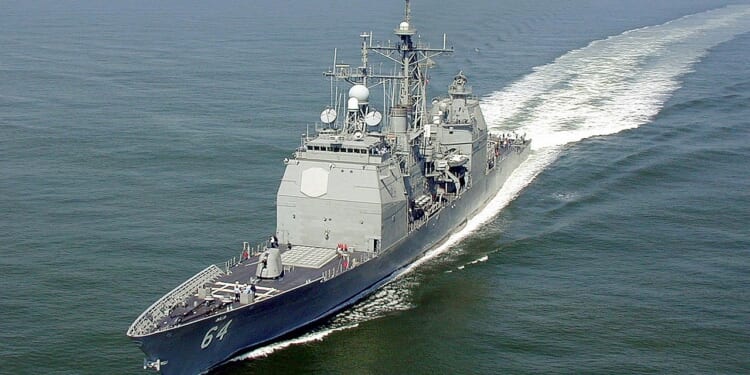Although the Gettysburg’s deployment is nominally to combat the amorphous threat of drug cartels in the region, it is plainly obvious the real mission is to destabilize the Maduro regime.
President Donald Trump has left many observers scratching their heads about whether he truly intends to deploy US forces to Venezuela, or if this is all some strange show he’s putting on. A flotilla of powerful United States Navy warships, and one Los Angeles-class attack submarine, currently sits off Venezuela’s coastline.
Recently, the Navy added another warship to the equation. A Ticonderoga-class guided-missile cruiser, the USS Gettysburg (CG-64). The warships joined the “counternarcotics/maritime security” task force that has been driving Venezuelan President Nicolas Maduro crazy.
Understanding the USS Gettysburg
- Year Commissioned: 1991
- Number Built: 27 in class (20 retired, 7 in service)
- Length: 567 ft (173 m)
- Beam (Width): 55 ft (16.8 m)
- Displacement: ~9,600 tonnes, fully loaded
- Engines: Four General Electric LM2500 gas turbine engines; four propellers
- Top Speed: ~32.5 knots (37.4 mph, 60 km/h)
- Range: ~6,000 nmi (6,900 mi, 11,000 km)
- Armaments:
- Two 61-cell Mk 41 VLS, with wide range of armaments
- Eight RGM-84 Harpoon missiles
- Two Mark 45 Mod 4 lightweight guns
- Two Mk 38 25mm machine guns
- 2–4 .50 caliber machine guns
- Two Phalanx CIWS
- Two Mk 38 25mm torpedo tubes
- Two MH-60R helicopters
- Crew: ~330 (30 officers, 300 enlisted)
The Gettysburg brings significant capabilities with it, adding to the already sizable offensive capabilities of the flotilla. As a Ticonderoga-class cruiser, the ship has the Aegis Combat System. More importantly, though, the warship brings with it a large number of the almighty Tomahawk Land-Attack Missiles.
Specifically, the Gettysburg carries the Mk41 vertical-launch cells that enable the warships to fire Tomahawk cruise missiles. These provide standoff strike capabilities against land targets.
These weapons will be key for any offensive campaign directed against Venezuela itself (thus far, all military activity has been relegated to the High Seas, directed against alleged drug trafficking boats). With these weapons, the Trump administration can direct a significant amount of firepower at distant targets deep inside Venezuela.
There’s the Aegis Combat System, too. This is a radar that provides layered air defense for nearby ships (tracking and engaging aircraft or anti-ship missiles) and contributes sensor data to a broader naval air picture and fire-control network. That capability protects high-value units such as carriers and amphibious ships. In turn, Aegis helps to shape the battlespace in the favor of the Americans.
Plus, the Gettysburg has anti-ship and surface-engagement weapons—and a five-inch gun that can provide limited naval gunfire support for forces ashore or for shaping littoral approaches (gunfire is useful for close support but is no substitute for precision strike systems).
The Gettysburg possesses embarked helicopters and onboard anti-submarine warfare (ASW) sensors to let the cruiser contribute to submarine detection and prosecution—important for protecting a larger force from the subsurface threat.
What Is the Gettysburg Doing Near South America?
Once engaged, the Gettysburg could assist in pre-strike shaping and intelligence, surveillance, and reconnaissance (ISR) missions. This warship could also protect any potential amphibious landing force by reducing the risk from air, missile, and submarine attack.
Although the Gettysburg’s deployment is nominally to combat the amorphous threat of drug cartels in the region, it is plainly obvious the real mission is to destabilize the Maduro regime in Caracas.
The exact rules of engagement, legal authorities, and mission remain murky. But the level of firepower and kind of systems the Trump administration has brought to bear—and considering how long they have done that—indicates there is a deeper plan afoot.
Indeed, the Gettysburg isn’t just a floating cruise missile launcher. It can contribute to the flotilla’s overall mission sets that include surveillance operations, air and missile defense, anti-submarine and surface escorts, and limited naval fire support to a larger US naval or joint operation.
Overall, the Gettysburg’s presence as part of the flotilla provides depth to the already impressive force assembled. Of course, few outside the White House have a real understanding of what comes next. But having the Gettysburg there, with the other US Navy warships and submarines, means that Maduro’s time as leader of Venezuela might be over sooner rather than later.
About the Author: Brandon J. Weichert
Brandon J. Weichert is a senior national security editor at The National Interest. Recently, Weichert became the host of The National Security Hour on America Outloud News and iHeartRadio, where he discusses national security policy every Wednesday at 8pm Eastern. He is also a contributor at Popular Mechanics and has consulted regularly with various government institutions and private organizations on geopolitical issues. Weichert’s writings have appeared in multiple publications, including The Washington Times, National Review, The American Spectator, MSN, and the Asia Times. His books include Winning Space: How America Remains a Superpower, Biohacked: China’s Race to Control Life, and The Shadow War: Iran’s Quest for Supremacy. His newest book, A Disaster of Our Own Making: How the West Lost Ukraine is available for purchase wherever books are sold. He can be followed via Twitter @WeTheBrandon.
Image: Wikimedia Commons.


















